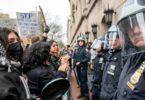Seana Sugrue
It feels like 1938 again. That was the last time the Supreme Court embarked on a path of far-reaching constitutional change. Once the champion of liberty of contract and states’ rights, the Court jettisoned those commitments in the span of one year to propose a new set of judicial priorities. It communicated these in its infamous footnote four in the Carolene Products case, and then began its work of showing deference to Congress in the economic sphere, while recrafting much of the Bill of Rights to offer greater protection for “prejudice against discrete and insular minorities.” Now, in 2022, the Court is again shuffling the deck amongst rights. Some rights are being elevated, particularly the free exercise of religion and the right to bear arms, while others are being demoted, including the establishment clause and rights of the accused. As was done in Carolene Products, the Court is communicating future doctrinal shifts in an understated fashion, in the form of breadcrumbs sprinkled in dicta.
One development hiding in plain sight is the demotion of the establishment clause. Not so long ago, it was virtually impossible for state funding to be allocated directly to religious institutions because, in 1971, the Supreme Court had created the much-maligned “Lemon test.” Its three prongs were created to prohibit funding to parochial schools, to forbid prayers in public schools, and to outlaw religious displays on public property. While Lemon was repudiated in dissents, concurrences, and scholarly commentary, it had not been flatly overruled. Mostly, it had been ignored by the Court. This term, Lemon has officially been sent to its grave. In Kennedy v. Bremerton School District, the case in which a football coach was fired for praying on the field, the majority wrote: “this Court long ago abandoned Lemon and its endorsement test offshoot.”
Lemon being dead is big news, especially in a case that wasn’t concerned primarily with the establishm-ent clause. But tying Lem-on’s demise to a rejection of the endorsement test, an alternative test that has be-en invoked only to prevent prayers to school children, leads to the prospect that prayers in public schools may soon be constitutionally permissible. Together, L-emon and the endorsement test cover the field of app-roaches the Court has taken to prohibit school prayers. Two of Lemon’s prongs were first articulated in Abington School District v. Schempp, and its companion case, Murray v. Curlett. Abington forbade morning readings from the Bible, while Murray forbade the Lord’s Prayer from being recited in a public school.
After Lemon, the endor-sement test was created by Justice O’Connor in nota-ble concurrences to deal with the issue of school prayers; her approach ultimately commanded a ma-jority in cases such as Lee v. Weisman. By overruling both Lemon and the end-orsement test, it is hard to see what now prevents sc-hool boards from mandating morning prayers, sho-uld they wish to reinstitute these. Kennedy may have involved a private prayer, decided on free exercise and speech grounds, but because of its establishment clause dicta, prayers may soon be reintroduced in public schools.
Miranda is another right that appears to be on the chopping block. Many can recite verbatim the Miranda warning, even if they have never been given it by a police officer prior to questioning in a custodial setting. Most everyone believ-ed that the Supreme Court had decided that it would be a violation of one’s Fifth Amendment right to be deprived of this warning before being questioned by the police. However, the Court has suggested otherwise this term. In the case of Vega v. Tekoh, the maj-ority announced: “Miranda did not hold that a violation of the rules it established necessarily constitute a Fifth Amendment violation.” Instead, the Court said that the Miranda warning is only “to safeguard [a right against self-incrimination] during a custodial interrogation.”
Vega was not decided in the context of a criminal c-ase so it remains to be seen whether an un-Mirandized confession, leading to a conviction, will be admissible into evidence. Vega only considered whether the failure of an officer to read the Miranda statement permitted the officer to be sued under federal law in a civil case for a violation of a constitutional right. Yet the Court’s conclusion that the Miranda warning is not a constitutional right, but a means of safeguarding a right, was based upon its interpretation of cases involving criminal convictions. How far the Court will take its new precedent in Vega remains to be seen. However, it is a fair conclusion that the erosion of the Miranda warning is underway.
The administrative state is a third domain in which formerly settled expectations are being shaken. U-ntil very recently, most be-lieved that Congress could delegate broad and almost standardless discretion to agencies without being told it was unconstitutionally delegating its lawmaking power. So long as “intelligible principles” were found in a statute, the Court found no constitutional problem. While the meaning of “intelligible principles” remained vague, the Court was inclined to discover they existed even in the most broadly worded delegations of rulemaking authority. The Court coupled its “intelligible principles” standard with Ch-evron deference so that, if Congress did not speak clearly (and it wasn’t ex-pected to) and an agency’s interpretation was reasonable, the Court would defer to an agency’s rules.
The Court defers no mo-re. Over the last year, the Court decided four “major questions” cases. Now, the Court will no longer tolerate agencies making transformative policy decisions based upon ancillary and vaguely worded statutory provisions. But the big news, for those interested in separation of powers, is that the Court appears to be toying with the idea of replacing the lax “intelligible principles” standard with a requirement that Congress must speak more clearly in delegating transformative regulatory powers to agencies.
In West Virginia v. EPA, the Court for the first time, in a majority opinion, referred to the “major questions doctrine” as being motivated by “separation of powers principles.” Justice Gorsuch, who expressed his wish to overrule the intelligible principles standard in his famous dissent in Gundy, spelled out in his concurrence that the major questions doctrine is related to the nondelegation principle that only Congress has the power to make law.
Here, the breadcrumb trail leads to a door ajar for the major questions doctrine to be elevated into a constitutional nondelegation rule.
The implications of what this would mean for the executive branch are so breathtaking—especially for regulatory commissions such as the FCC or SEC or for agencies such as OSHA or FDA—and the originalist case for the major questions doctrine is so hotly contested, that the Court should be expected to move slowly before taking that plunge.






